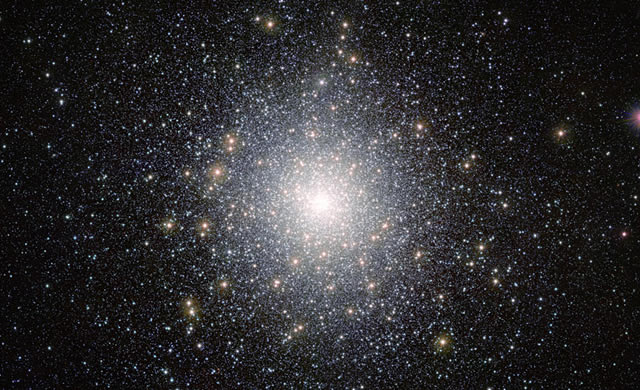
Questa nuova immagine infrarossa del telescopio VISTA dell’ESO mostra l’ammasso globulare 47 Tucanae con un dettaglio sorprendente. Questo ammasso contiene milioni di stelle e molte tra quelle annidate al suo interno ci appaiono esotiche e mostrano proprietà insolite. Studiare gli oggetti all’interno di ammassi come 47 Tucanae ci aiuta a capire meglio come queste strane sfere si formano e interagiscono. Questa immagine è molto nitida e profonda grazie alla dimensione, sensibilità e ubicazione di VISTA, all’Osservatorio del Paranal dell’ESO in Cile.
Gli ammassi globulari sono grandi nubi sferiche di stelle vecchie legate dalla gravità reciproca. Orbitano intorno al nucleo delle galassie, così come i satelliti orbitano intorno alla Terra. Questi grumi di stelle contengono pochissima polvere e gas – si pensa che la maggior parte sia stata soffiata via dall’ammasso dai venti stellari e dalle esplosioni delle stelle in esso contenute, o strappata dal gas interstellare che interagisce con l’ammasso. Tutto il materiale rimasto si è fuso a formare stelle miliardi di anni fa. Gli ammassi globulari accendono l’interesse degli astronomi – 47 Tucanae, noto anche come NGC 104, è un ammasso globulare enorme e antico, a circa 15 000 anni luce da noi, e contiene molte stelle e sistemi stellari bizzarri e interessanti.
Fonte/Leggi tutto → ESO.org
This new infrared image from ESO’s VISTA telescope shows the globular cluster 47 Tucanae in striking detail. This cluster contains millions of stars, and there are many nestled at its core that are exotic and display unusual properties. Studying objects within clusters like 47 Tucanae may help us to understand how these oddballs form and interact. This image is very sharp and deep due to the size, sensitivity, and location of VISTA, which is sited at ESO’s Paranal Observatory in Chile.
Globular clusters are vast, spherical clouds of old stars bound together by gravity. They are found circling the cores of galaxies, as satellites orbit the Earth. These star clumps contain very little dust and gas — it is thought that most of it has been either blown from the cluster by winds and explosions from the stars within, or stripped away by interstellar gas interacting with the cluster. Any remaining material coalesced to form stars billions of years ago. These globular clusters spark a considerable amount of interest for astronomers — 47 Tucanae, otherwise known as NGC 104, is a huge, ancient globular cluster about 15 000 light-years away from us, and is known to contain many bizarre and interesting stars and systems.
Source/Continue reading → ESO.org





















